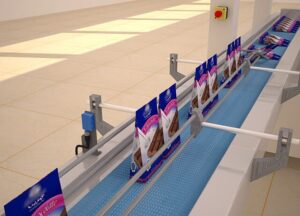During high-speed production of retail bags, a confectionery manufacturer conveys individual bags of sweets to a pick-and-place packing robot for secondary packaging. A highly reliable diffuse-mode photoelectric sensor, mounted beside the conveyor, detects the presence of bags as they approach the packing station and inhibits the pick-and-place sequence if no bags are queued for the packing robot.
The application
In the food-processing industry, consumer products generally require secondary packaging – both for consolidation and for protection, before final dispatch. During confectionery production, individual bags of sweets travel by conveyor from bagging stations to a pick-and-place packing robot for secondary packaging, before passing on to the labelling and packing area.
Ideally, product flow along the conveyor is continuous; in practice, interruptions occur from time to time as bagging machines require attention. In the absence of bagged products arriving at the secondary-packaging station, a plant-wide control system prevents operation of the pick-and-place robot to prevent mis-filling.
Immediately prior to arrival at the secondary-packaging station, custom-formed guide rails align bags for packing. Space is limited and there is no easy access to both sides of the conveyor. A highly reliable non-contact sensor system was needed to detect the presence of bags as they approach the alignment rails; the system must inhibit the pick-and-place sequence if no bags are queued for packing.
The solution
Diffuse-mode photoelectric sensors from the Contrinex C23PA family of sensors are ideal for this application. These highly reliable devices contain both a transmitter and a receiver and do not require a separate reflector, instead relying on the reflective nature of the target. Space constraints are accommodated without compromise, thanks to a maximum sensing range of 3 to 1500mm. This is adjustable via a pre-set potentiometer or via IO-Link, the standardised point-to-point serial connection protocol.
Immediately before the alignment rails, a single sensor is mounted beside the conveyor; positioning sensors is simple thanks to a range of adjustable mounting brackets. As each bag passes in front of the sensor, its presence triggers the device, sending a signal to the customer’s control system. A high-intensity red LED with a 15mm-diameter light spot at the selected 500mm sensing range ensures highly reliable detection of bags in real-time.
Mounted in 20mm x 30mm x 10mm miniature plastic housings, C23 photoelectric sensors are available with industry-standard PNP or NPN 3‑wire or 4-wire output. Connection to the customer’s control system is via a PVC-sheathed cable with the choice of an integral M12 connector or a hermetically sealed entry. A second output provides a stability alarm in the event of reduced sensitivity, flagging the need for preventative maintenance before any performance degradation occurs.
Contrinex sensors and more information are available from PLUS Automation.
 Instrumentation Monthly Test | Measurement | Control
Instrumentation Monthly Test | Measurement | Control











